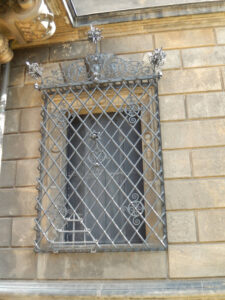
The latest evidence in the case of Dresden’s ‘heist of the century’, during which jewels belonging to Augustus II the Strong were stolen, have led detectives to Berlin. Throughout September 2020, officials from both the State Office of Criminal Investigations (Landeskriminalamt) and Uniformed Police have been searching apartments and commercial properties there. The new clues could lead to the capture of the thieves who broke into the Historic Green Vault in 2019. At the time, ‘Europe’s treasure chamber’ was considered to be well secured.

Planned Meticulously, Completed In Minutes
Shortly before 5 a.m. on 25 November 2019, the thieves set fire to a power box, thereby disabling the lights on Theaterplatz in front of Dresden Castle. They cut through the wrought iron bars on the window, smashed the safety glass window out of its brackets and climbed into the Historic Green Vault. They crossed through the Hall of Treasures into the adjoining Coats of Arms Room and from there, they entered the Jewel Chamber. It is still unclear why this didn’t trigger any alarms at the time.
A surveillance camera captured the thieves breaking a display case with an axe before hurriedly taking out the contents. The stolen items belonged to three jewellery sets dating back to the time of Elector of Saxony Augustus II the Strong: the Jewellery of the Queens, the Diamond Rose Set and the Brilliant Set. Two security guards saw the incident, but they were not permitted to intervene themselves as they were unarmed; all they could do was notify the police. The thieves scattered fire-extinguishing powder around the room and were gone as quickly as they’d come. You can watch an initial reconstruction of the crime in this documentary:
Following Clues – From Dresden To Berlin
This method is reminiscent of the bold break-in at the Bode Museum, which was carried out by an organised crime gang. However, detectives do not yet have any evidence to suggest that a Berlin gang might also be behind the spectacular stunt in Dresden.
The stolen items, which are considered unsellable due to their uniqueness, are yet to be found. These items include parts of a diamond necklace worn by Queen Amalie Auguste, a breast star of the Polish Order of the White Eagle and an epaulette (shoulder piece) with the 50-carat Dresden White Diamond, which has been in Saxony’s possession since 1728.
The special commission established to investigate the case, named ‘Epaulette’, now believes there were seven perpetrators involved. The police have offered a reward of half a million euros for any information that helps them to capture the thieves or recover the jewels.
On the day of the break-in, officers found the getaway car, a light-coloured Audi S6 with a dark roof, which was caught on camera. The burnt-out vehicle was found in an underground car park in Dresden. But upon close examination, it became clear that the (stolen) car had originally been blue; a different-coloured car wrapping film had been applied shortly before the heist in order to erase any evidence.
On 9 September 2020, the police searched several businesses in Berlin that may have professionally wrapped the car. According to media reports, the prosecutor’s office made it immediately clear that the business owners were only being questioned as witnesses: ‘At this point of the investigation, we can assume that these businesses did not know the reason the suspects were getting their car wrapped.’ The police seized any business records and data that could help to ascertain the identity of the thieves.
There’s also a second trail of clues leading to Berlin, specifically to a man believed to sell mobile phone SIM cards registered with fictitious personal details. The thieves are thought to have bought SIM cards from him and used them to communicate with each other while they organised and carried out the heist. It is not yet clear whether this man knew what the SIM cards would be used for. Again, the police seized all documents, mobile phones and any other material that could help them track down the suspects. We’ll keep you posted.
Security In Museums: A Difficult Subject
As these investigations continue, the security measures in the Historic Green Vault are also coming under scrutiny and criticism. The museum had already decided to replace its outdated surveillance cameras back at the end of 2018. There are also plans to improve the security measures on the façade and around the display cases. Since then – and also as a result of the Dresden heist – several expert meetings have been held to discuss the subject of security in museums.
Questions about what security measures are realistic had already been raised after the break-in at the Bode Museum in Berlin, during which the giant gold coin ‘Big Maple Leaf’ was stolen. In that case, the thieves were apprehended, although the ‘Big Maple Leaf’ itself remains lost. While the break-in at the Bode Museum was carried out by an organised crime gang, a similarly brazen robbery at the Kaiser Wilhelm Memorial Church in Berlin, during which a number of orders were stolen, turned out to be the work of a petty criminal.
ArtNews reported on the search of the SIM card dealer.
The MDR has released multiple reports providing the latest updates from the investigation in Dresden (in German): investigations into the getaway car and the SIM card dealer.




